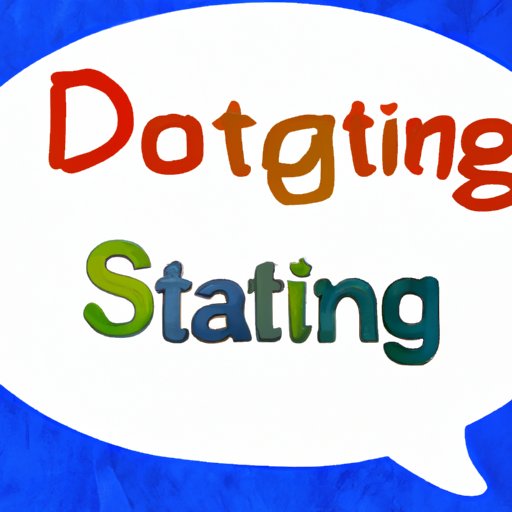Introduction
Writing a chapter in a book or novel can be intimidating, especially if you’re not sure where to start. It can be hard to figure out how to make the introduction interesting enough to keep readers engaged. Fortunately, there are some tried-and-true techniques for creating an effective and engaging introduction to your chapter. This article will explore how to start a chapter, from identifying the purpose of the chapter to crafting an engaging and memorable introduction.

Identifying the Purpose of the Chapter
Before you start writing, it’s important to know the purpose of the chapter. Ask yourself questions such as: What is the main point I want to make in this chapter? How do I want to structure the content? What do I want readers to take away from this chapter? Answering these questions will help you decide what to include in the chapter and how to organize it.
Crafting an Engaging Introduction
Once you’ve identified the purpose of the chapter, it’s time to begin crafting an engaging introduction. You should always aim to write an introduction that grabs the reader’s attention and sets the stage for the rest of the chapter. Here are some tips for writing an effective introduction:
Writing a Hook
The first step to writing an engaging introduction is to create a “hook” that will draw the reader in. According to author and writing coach Rayne Hall, “A hook is an opening sentence which draws the reader into the piece of fiction and encourages him to read on.” A good hook should be unexpected, intriguing, and relevant to the story. Try asking yourself what would surprise your readers or make them curious about the chapter. Use this idea to craft an interesting and unique hook.
Developing a Theme or Tone
Your introduction should also set the overall theme or tone of the chapter. Think about the emotions you want to evoke in your readers, and choose words and phrases that reflect those feelings. For example, if you’re writing a suspenseful chapter, you might want to use words like “tense” or “trembling” to set the mood. If you’re writing a romantic chapter, you might choose words like “love” or “passion”.

Establishing a Sense of Place
The introduction should also provide some context for the reader by establishing a sense of place. Describe the setting of the chapter, whether it’s a physical location or a mental state of mind. Give the reader a sense of what the chapter looks and feels like. This will help to orient the reader and make them feel like they’re part of the story.
Writing a Compelling Hook
Creating a compelling hook is essential for drawing readers in and getting them invested in the story. There are several ways to write an effective hook. Here are a few ideas:
Creating Suspense
One way to create an effective hook is to introduce a bit of suspense. Try starting the chapter with a question or a mystery that will leave the reader wanting to know more. For example, you could start a chapter by saying, “Who was the mysterious figure lurking in the shadows?” This type of hook will make readers curious and eager to find out what happens next.
Using Vivid Imagery
Another way to create an effective hook is to use vivid imagery to paint a picture in the reader’s mind. Choose words that evoke strong visuals, like colors, smells, and textures. This will help readers to connect with the story on a deeper level and get invested in the characters and plot.
Introducing Characters
You can also create a compelling hook by introducing characters. Introduce the characters in an intriguing way that will make readers want to learn more about them. For example, you could start a chapter by describing a character’s appearance or behavior. This will give readers an immediate connection to the character and make them eager to learn more.
Establishing Tone and Setting
In addition to writing an engaging hook, you should also establish the tone and setting of the chapter. This will help readers to understand the mood of the scene and become immersed in the story. Here are some tips for establishing tone and setting:
Exploring the Setting
Start by exploring the setting of the chapter. Where does the chapter take place? Describe the physical location and any other details that are important to the story. This will help readers to visualize the scene and become more invested in the characters and plot.
Establishing the Mood
The next step is to establish the mood of the scene. Think about the emotions you want to evoke in your readers and choose words that reflect those feelings. For example, if you’re writing a suspenseful chapter, you might want to use words like “tense” or “trembling” to set the mood. If you’re writing a romantic chapter, you might choose words like “love” or “passion”.
Choosing the Right Words
Finally, make sure to choose the right words to convey the desired tone and mood. According to a study published in the journal Reading Psychology, “The choice of words used to describe a situation can have a significant impact on how readers interpret the text.” Pay close attention to the words you use and make sure they accurately reflect the mood of the scene.

Beginning with Action or Dialogue
Once you’ve established the tone and setting, it’s time to start the chapter. One way to do this is to start with action or dialogue. Writing dialogue can be a great way to introduce characters and move the story forward. Make sure the dialogue is interesting and reveals something about the characters. Starting with action can also be effective, as long as it’s interesting and relevant to the story.
Conclusion
Writing an engaging introduction to your chapter is essential for keeping readers interested and invested in the story. Start by identifying the purpose of the chapter and deciding on its content and structure. Then, craft an effective hook that will draw readers in, and use vivid imagery to create a sense of place. Finally, establish the tone and mood of the chapter and begin with action or dialogue. By following these steps, you can write an engaging introduction to your chapter that will keep readers hooked from start to finish.
(Note: Is this article not meeting your expectations? Do you have knowledge or insights to share? Unlock new opportunities and expand your reach by joining our authors team. Click Registration to join us and share your expertise with our readers.)
